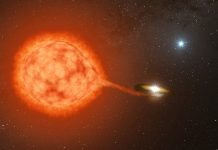
Recent research suggests that dark matter, previously thought to be non-collisional, might actually interact with itself.
This conclusion comes from a study led by Riccardo Valdarnini of the Scripps Institution of Oceanography at UC San Diego, and it was published in the journal Astronomy & Astrophysics.
Using advanced numerical simulations, the study analyzed the “El Gordo” cluster, a massive cosmic structure located seven billion light years away.
Dark matter is a mysterious substance that makes up about 90% of the universe’s matter. Unlike regular matter, it doesn’t emit, absorb, or reflect light, making it invisible and detectable only through its gravitational effects.
The standard model of cosmology, known as the Cold Dark Matter (CDM) model, assumes that dark matter particles are cold and collisionless, interacting only through gravity.
However, some observations do not fit this model, leading scientists to explore alternative theories.
One such theory is the Self-Interacting Dark Matter (SIDM) model. This model proposes that dark matter particles can collide and exchange energy.
To test this theory, researchers often turn to galaxy clusters, the largest structures in the universe, which can reveal unique insights when they collide.
“El Gordo” is one such cluster, with a mass about a quadrillion times that of the sun. Its unusual properties have made it a focus of many studies.
According to Valdarnini, studying the separations between different mass components in such clusters can provide clues about dark matter’s nature.
In a galaxy cluster merger, the behavior of gas, galaxies, and dark matter differs. Gas, being collisional, loses energy and lags behind the non-collisional dark matter and galaxies after a collision. However, in “El Gordo,” the researchers observed something different. The peak of dark matter density was separated from that of the gas and galaxies, which fits the SIDM model’s predictions.
The study found that in the southeastern (SE) subcluster of “El Gordo,” the peak of X-ray emissions (which shows the gas mass) is ahead of the dark matter peak.
Additionally, the brightest cluster galaxy (BCG) lags behind the X-ray peak and is offset from the SE mass centroid. Similar observations were made in the northwestern (NW) subcluster.
To explain these observations, Valdarnini used N-body/hydrodynamical simulations, which model the gravitational and hydrodynamic interactions in galaxy clusters. The simulations showed that the observed separations between the mass centroids in “El Gordo” could be naturally explained if dark matter is self-interacting.
“The most significant result of this study is that the separations observed in ‘El Gordo’ suggest that dark matter is self-interacting,” said Valdarnini. “These findings provide evidence of dark matter behavior that exhibits collisional properties in high-energy cluster collisions.”
However, there are some inconsistencies. The SIDM model’s cross-section values obtained from the simulations are higher than current upper limits, suggesting that the SIDM model might be a low-order approximation. The physical processes describing dark matter interactions in cluster mergers are likely more complex than current models assume.
This study offers a new perspective on dark matter, challenging the standard collisionless paradigm and opening the door to further research. Understanding dark matter’s true nature is crucial for unraveling the mysteries of the universe.



